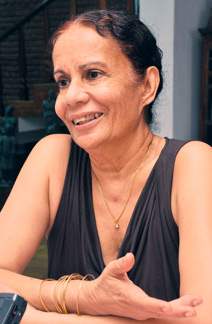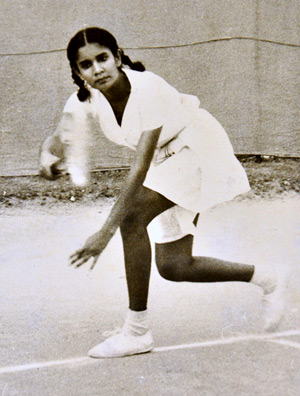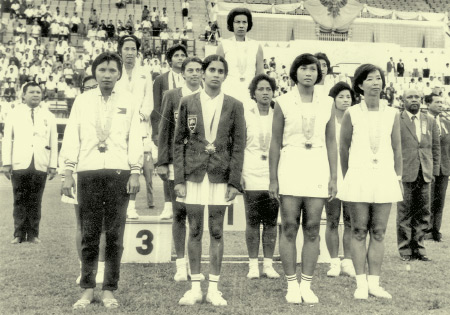Tennis has played a significant role in my life - Sriya
Gooneratne
By Ranjan Anandappa
Past Sri Lanka Tennis Stalwarts ..... Remember Sriya Gooneratne! a
doyenne of Sri Lanka tennis in the early 1960's and 70's? She was a
household name at tennis in Sri Lanka on the women's front. Sriya was a
part of a new generation of emerging talent and was a player in the
company of Rukmani Kodagoda, Ranjini Jayasuriya, Bernard Pinto, Rupert
Ferdinands and Wendy Molligoda.
|

Pic: Susantha Wijegunasekera |
Sriya Gooneratne was a member of the women's tennis team which
participated at the 1966 Asian Games in Bangkok and won the 'bronze'
medal in the team event. The other members of the team were Wendy
Molligoda and Ranjini Jayasuriya.
Sriya was of course a very young player and very much junior to other
veterans mentioned. However she thought being in their company and at
times playing against those players were a sheer education. She thought
that the present day players did not have the opportunity to play with
or against top local players that would have helped them a great deal in
their tennis career.
An old girl of Holy Family Convent, Bambalapitiya, but she never
represented HFC at tennis, but, after joining Visakha, she got into the
main stream of tennis and thereafter it was a continuous competitive
tennis career for her.
Excerpts of the interview
Q: When did you really start your
tennis career?
A: I started playing
tennis at the age of about 11 years. In today's context, 11 is a little
too old to start, but my father was of the opinion that bones and
muscles have to be developed before one is ready to wield a tennis
racquet. Those were the days where junior racquets were unavailable,
instead, the lighter version of the normal racquet. I was impatient to
start so I had the dubious privilege of picking balls and watching
others play matches.
Q: Who was your coach at that time?
A: There were no coaches.
My father was the self appointed coach, mentor and the one with all the
patience to teach a beginner and the rock I depended on. I came from a
tennis playing family-Both my parents, my elder brothers and younger
sisters all played good tennis. So I had tennis in my blood from the
beginning. I am proud to say that I was a product of the SLTA which I
consider as my second home. I loved the centre court with its terraced
steps and was totally motivated by the large crowd that used to watch
the tennis nationals during the sixties.
Q: When did you play your first
National Championship?.
A: At the age of 13 years,
by that time I had learnt to play the forehand, backhand and the serve.
I had been drawn with the reigning national champion. I was looking for
ways and means to combat the champion and I was browsing a tennis book
to find out the way to face the situation. I could still remember the
instructions given in the manual. "Get into the ready position, watch
the ball, bend your knees and follow through". I thought that was easy
enough to follow while playing and I would be in with a chance. But I
was beaten soundly by the national champion. But a few years later, I
beat her.
Q: Which year did you win a major
game?
|

Sriya then at a tennis tie |
A: 1962 was a significant
year when I beat India's number 3 R. Thadani at the Nationals held in
Nuwara-Eliya. At that time, the importance never registered in my mind.
My mother had newspaper clippings of the achievement, and only on
reading them I had realised that I had hit the headlines of the sports
page. I remember the moans and groans of the crowd when I missed 3-match
points and finally won it in the fourth.
I had to meet India's number 1 Dechu Aappiah in the final and I lost.
In 1963, I won the Colombo Tennis Championship for the first time and
won it for five consecutive years till 1968. This was the only 'A' grade
tournament and only second to the Nationals with most of the local
players taking part. In the 1960's and 70's our National Championship
attracted foreign players from India, Indonesia and Philippines. Our
women players were on par with the Indian players and we used to have
the Mysore-Ceylon 'tie' and the Indo-Ceylon 'tie'.
Q: What happened in 1964?
A: In 1964, I won the
Colombo Championship, but from that point onwards it was a downward
journey. I decided to keep off from tennis for sometime. But once again
the tennis 'bug' in me got activated. My father insisted that I should
gain weight more than 85 lbs if I want to continue with the game. I knew
that I would not be able to achieve this target. So I wore about three
layers of heavy clothing (which my father, being a man would never
notice) I got on to the scale and did tip over the specified
requirement.
Q: You were yet to win a National
Tennis Championship during that period ?
A: I have to mention how
grateful I am to Percy Ernst (a former national champ) who started
coaching me from 1965 free of charge. He felt that it was high time that
I won a national title under any conditions. His theory was that I
should perfect my ground strokes and be able to hit the ball hard
wherever I wanted to and get winners. I had developed a unique backhand
which was my lethal weapon. Unfortunately my service never matched my
ground strokes.
Q: Tell me how you felt while
representing the country at the 1966 Asian Games?
A: In 1966 I achieved
another land mark by being the first local to beat a former Ceylon
champion at the Nationals. I was also selected for the Asian Games to
play in the singles event for Sri Lanka. I was very proud to bring home
a bronze medal, which we won for the team event. I have to relate a back
ground story with regard to the Asian Games since I almost never made it
to Bangkok. At that time, the government had implemented foreign
exchange controls and there was no money to send the contingent of
players for the Asian Games. Two days before our departure my father got
to know that we were to be sent by a military transport plane and he put
his foot down and said that no way was he going to give me permission to
go. I was totally shattered - after all the trials, hard training etc, I
went on strike. I refused to eat and locked myself in my room, crying my
heart out. Fortunately my mother intervened and persuaded my father to
allow me to go. So that afternoon, I went to the Exchange Control
Department to get my meager allowance of 3 pounds and 10 shillings to
travel the next day.
Q: What happened there after?
A: In the same year 1966,
I tried to qualify for Wimbledon but was unable to make it through to
the qualifying rounds. Being a clay court player, it was almost
impossible to get used to the U.K. grass courts within a week. I also
played in the Indian tennis circuit in Bangalore, Madras and Kerala
reaching the semi-finals in the All-India hard court championships.
In 1967 Nationals, I once again lost to Indonesia's number 1 Lita Lim
in the final. She was not only ambidextrous, but also a top spinner. No
one taught us to top spin the ball at that time. So it took almost a set
to get used to the top spin. But finally I won the Nationals in 1968 and
1969.
Q: Did you ever think of giving up
tennis after winning the National Championship?
|

Sriya Gooneratne (second from left) in big company with
Wendy Molligoda and Ranjini Jayasuriya (behind) members of
the 1966 Sri Lanka women’s tennis team who won the bronze
medal at the 1966 Asian Games held in Bangkok at the medal
awarding ceremony. |
A: I thought that was it,
where tennis was concerned, but it was not to be. Marriage in 1970 to
Mohan Munasinghe whom I had met at the age of 15 and residing in
Montreal, Canada and a baby in 1973 could not prevent the irresistible
pull to get on to the tennis court once again. Tennis for us poor
students was only possible in the summer and that too in the university
courts. So in the summer of 1974, I started to practice seriously again,
this time my coach, sparring partner, strategist and everything else was
Mohan. We had no extended family, no support system. This was a sharp
contrast to the days I played in Colombo where everything was done for
me, having my clothes ironed and kept ready, sand meals ready etc. I had
to get on to the tennis court and only play.
Q: How competitive was tennis in
Canada?
A: In Montreal time
management was a key factor to me. I had only 1 or 2 hours of practice
every day and that too when a nine month old baby did take her nap. So I
learnt the art of concentrated practice and put in more than 100%
effort. Playing matches another episode.
I had no time to feel nervous,since unto the last minute I had to see
that the baby's food etc were all ready so that my husband Mohan could
look after her while I was playing. Anyway to cut it short I played my
best tennis during this period and I was ranked No 2 in the province of
Quebec in 1975. That year Canada's number 1 Andre Martin was also
Quebec's N0.1. I took her to three sets but never managed to defeat her.
The tennis saga continued thereafter.
From 1977 onwards we used to visit Sri Lanka every summer and the the
nationals was still an attraction. So when I was asked by Manisha Perera
to partner her in the doubles, I could not refuse. No one knew I was
five months pregnant with my second baby.
We came to the semi-finals, but unfortunately weekes into the
tournament, my balance was quite different to when I started and we
lost. In 1986 partnering Manisha again we won the National Ladies
Doubles after a gruelling three-setter and made up for the for the 1977
loss.
Q: How many titles have you won in
your long tennis career?
A: I have won the Ladies
singles and the ladies doubles titles twice at the Nationals, but not
the mixed doubles. In my senior years Mohan and I decided to play in the
over 40 mixed doubles at the Nationals and won the title three times
consecutively.
After returning to Sri Lanka in 2002, I continued to play in the
All-Island Inter-Club Tournaments. A few years ago, I thought 50 years
of competitive tennis in one form or another is enough.
I still play regularly and still have the competitive spirit to play
well and try to hit the ball as hard as I did when I was a teenager. As
you can see, tennis had played a major role in my life and has thought
to face defeat as well as victory in the same spirit and calmness. |

